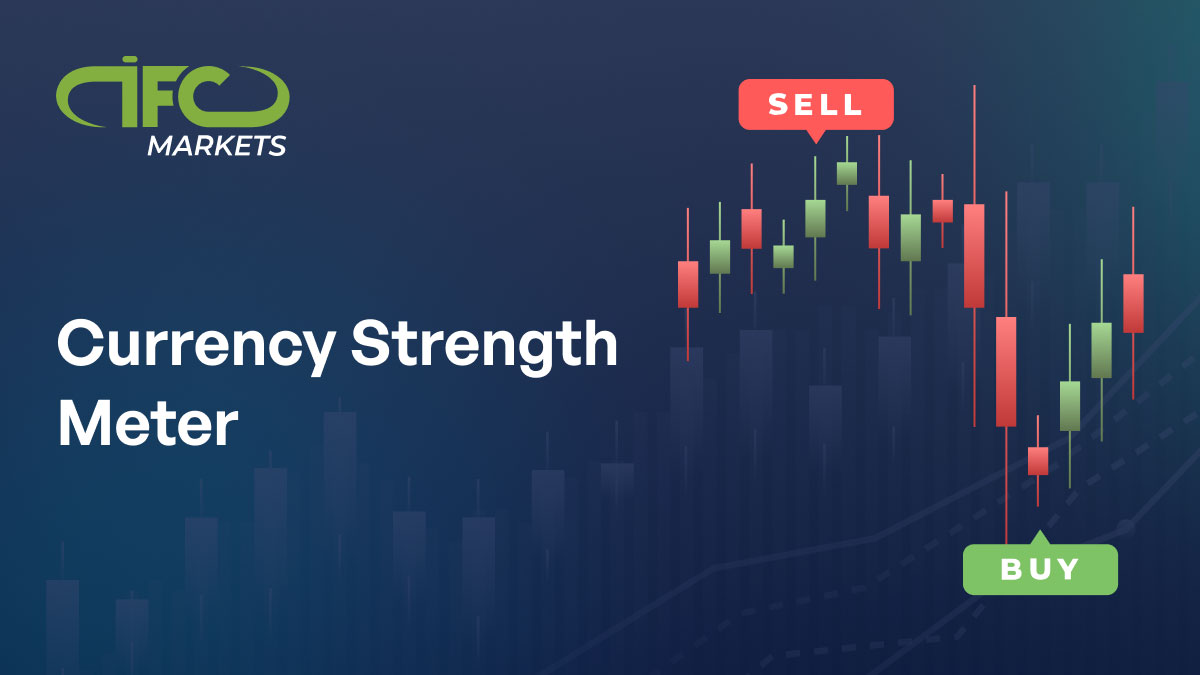- Education
- Forex Technical Analysis
- Technical Indicators
- Trend Indicators
- Currency Strength Meter
Currency Strength Meter: Definition, Formula and How to Use
Forex trading involves the buying and selling of different currencies in the global market. Traders strive to make profitable trades by predicting the movement of currency pairs. To make informed decisions, traders rely on various tools and indicators, one of which is the Currency Strength Meter.
In this article, we will explore what a Currency Strength Meter is, how to use it effectively, and the formula and calculation behind it.

What is Currency Strength Meter
A Currency Strength Meter is a visual tool that provides traders with a snapshot of the relative strength of different currencies. It is designed to assist traders in identifying the strongest and weakest currencies at any given moment. By analyzing the strength or weakness of currencies, traders can make more accurate predictions about future price movements.
The Currency Strength Meter represents the performance of individual currencies in relation to other currencies in the Forex market. It helps traders identify which currencies are experiencing positive or negative price momentum. By focusing on strong currencies and pairing them with weak ones, traders can increase their chances of executing profitable trades.
How to Use Currency Strength Meter
Using a Currency Strength Meter requires a basic understanding of how it works and how to interpret the information it provides.
Here are the steps to effectively use a Currency Strength Meter:
- Choose the right time frame
- Consider other factors
- Use the currency strength meter in conjunction with other technical analysis tools
- Identify strong and weak currencies
- Identify potential trading signals
- Confirm trading signals
1. Choose the right time frame
The currency strength meter can be used to identify strong and weak currencies in both the short-term and long-term. However, the time frame you choose will affect the way the indicator behaves.
For example, if you are using the currency strength meter to identify short-term trends, you may want to use a shorter time frame, such as 1 day or 5 days. If you are using the currency strength meter to identify long-term trends, you may want to use a longer time frame, such as 1 month or 1 year.
Example: If you are interested in trading the EURUSD currency pair, you could use the currency strength meter to identify whether the euro or the US dollar is stronger. If the currency strength of the euro is higher than the currency strength of the US dollar, it means that the euro is stronger and you could consider buying EUR/USD.
2. Consider other factors
The currency strength meter is a useful tool, but it is not the only factor you should consider when making trading decisions. You should also consider other factors, such as economic news, political events, and interest rates.
Example: If the currency strength of the euro is increasing, but there is also bad economic news coming out of Europe, you may want to reconsider buying EUR/USD.
3. Use the currency strength meter in conjunction with other technical analysis tools
The currency strength meter can be used in conjunction with other technical analysis tools, such as moving averages, Bollinger bands, and the relative strength index (RSI). This will help you to get a more comprehensive view of the market and identify potential trading signals.
Example: If the currency strength of the euro is increasing and the RSI is also overbought, this could be a signal that the euro is about to reverse course and start to depreciate in value.
4. Identify strong and weak currencies
The currency strength meter can be used to identify which currencies are strong and which currencies are weak. This information can be used to make trading decisions, such as whether to buy or sell a currency.
Example: If the currency strength of the euro is higher than the currency strength of the US dollar, it means that the euro is stronger and you could consider buying EUR/USD.
5. Identify potential trading signals
The currency strength meter can be used to identify potential trading signals. For example, if the currency strength of a currency starts to increase, it may be a signal that the currency is about to appreciate in value.
6. Confirm trading signals
The currency strength meter can be used to confirm trading signals generated by other technical analysis tools. For example, if the RSI is overbought and the currency strength of a currency is also high, it may be a signal that the currency is about to reverse course and start to depreciate in value.
Currency Strength Meter Formula
The currency strength meter formula provides a means to assess the relative strength of a currency compared to others. It involves calculating the percentage change in a currency's price over a specified time period and comparing it to the percentage changes in other currencies.
The formula for the currency strength meter is as follows:
Currency Strength = (% Price Change in Currency) / (Average % Price Change in All Currencies)
In this formula:
- Currency Strength represents the strength of the currency relative to others.
- % Price Change in Currency refers to the percentage change in the currency's price over the given time period.
- Average % Price Change in All Currencies represents the average percentage change in the prices of all currencies over the same time period.
The currency strength meter helps identify strong and weak currencies, enabling traders to make informed trading decisions, such as whether to buy or sell a particular currency.
Here's an example illustrating how the currency strength meter can be utilized:
Let's consider assessing the strength of the US dollar compared to the euro. We would first calculate the percentage change in the US dollar's price over the designated time period. Let's assume the percentage change is 2%. Next, we calculate the average percentage change in all currency prices over the same time frame, which we'll assume to be 1%.
Currency Strength Meter Calculation
While the exact calculation may vary, the general steps involved in calculating the Currency Strength Meter are as follows:
- Gather currency price data: The Currency Strength Meter requires historical price data for each currency in the basket. This data is typically obtained from reliable sources or trading platforms.
- Calculate the relative strength index (RSI): Apply the RSI formula to the price data of each currency. The RSI is usually calculated over a specific period, such as 14 days. The RSI values range from 0 to 100, with values above 70 indicating overbought conditions and values below 30 suggesting oversold conditions.
- Compare RSI values: Compare the RSI values of each currency to determine their relative strength. Higher RSI values indicate stronger currencies, while lower values suggest weaker currencies.
- Display the results: Present the relative strength values of each currency in an easy-to-read format, such as bars, graphs, or numerical scores. This allows traders to quickly assess the strength and weakness of currencies.
To determine the currency strength of the US dollar, we use the following calculation:
Currency Strength = (2%) / (1%) = 2
This result indicates that the US dollar is twice as strong as the average currency during the specified time period.
While the currency strength meter is a versatile indicator for identifying strong and weak currencies, it's crucial to recognize its limitations. The currency strength meter can sometimes generate false signals, which is why it's advisable to use it in conjunction with other technical analysis tools.
Bottom Line on Currency Strength Meter
The Currency Strength Meter is a valuable tool for Forex traders, providing a quick and visual assessment of the relative strength or weakness of currencies. By identifying strong and weak currencies, traders can make more informed trading decisions and increase their chances of success.
When using a Currency Strength Meter, it is essential to remember that it is just one of many tools available to traders. It should be used in conjunction with other technical and fundamental analysis methods to validate trade setups and avoid relying solely on a single indicator.
As with any trading tool, it is recommended to practice using a Currency Strength Meter in a demo account or with small positions before applying it to live trading. This allows traders to familiarize themselves with its features and develop a strategy that works best for their individual trading style.
In conclusion, a Currency Strength Meter offers a valuable perspective on the relative strength of currencies in the Forex market. By incorporating this tool into your trading arsenal and understanding its calculations, you can gain an edge in identifying potential trade opportunities and improving your overall trading performance.
Forex Indicators FAQ
What is a Forex Indicator?
Forex technical analysis indicators are regularly used by traders to predict price movements in the Foreign Exchange market and thus increase the likelihood of making money in the Forex market. Forex indicators actually take into account the price and volume of a particular trading instrument for further market forecasting.
What are the Best Technical Indicators?
Technical analysis, which is often included in various trading strategies, cannot be considered separately from technical indicators. Some indicators are rarely used, while others are almost irreplaceable for many traders. We highlighted 5 the most popular technical analysis indicators: Moving average (MA), Exponential moving average (EMA), Stochastic oscillator, Bollinger bands, Moving average convergence divergence (MACD).
How to Use Technical Indicators?
Trading strategies usually require multiple technical analysis indicators to increase forecast accuracy. Lagging technical indicators show past trends, while leading indicators predict upcoming moves. When selecting trading indicators, also consider different types of charting tools, such as volume, momentum, volatility and trend indicators.
Do Indicators Work in Forex?
There are 2 types of indicators: lagging and leading. Lagging indicators base on past movements and market reversals, and are more effective when markets are trending strongly. Leading indicators try to predict the price moves and reversals in the future, they are used commonly in range trading, and since they produce many false signals, they are not suitable for trend trading.

Not sure about your Forex skills level?
Take a Test and We Will Help You With The Rest
You can see the graphical object on the price chart by downloading one of the trading terminals offered by IFC Markets.

Was this article helpful?
 You can study CFD trading more thoroughly and see CFD trading examples in the section How To Trade CFDs Visit Educational Center
You can study CFD trading more thoroughly and see CFD trading examples in the section How To Trade CFDs Visit Educational Center 

